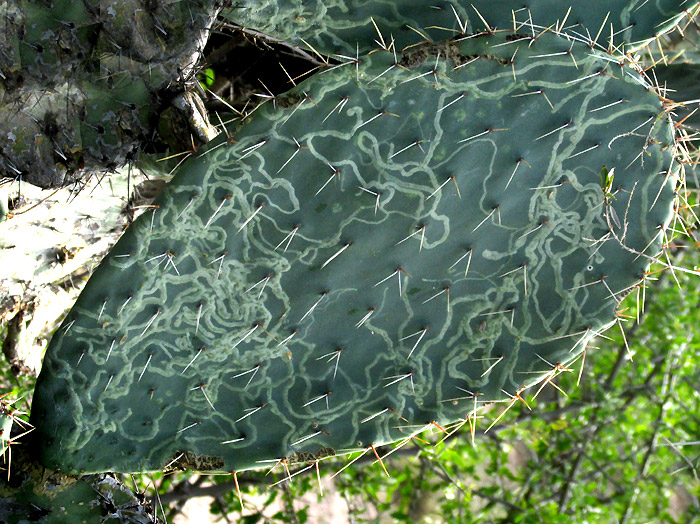Excerpts from Jim Conrad's
Naturalist Newsletter
Entry dated August 11, 2023, issued from near Tequisquiapan, elevation about 1,900m (6200 ft), Querétaro state, MÉXICO
(~N20.57°, ~W99.89°)
OPUNTIA LEAFMINER TRACES

The above squiggles on a pad of Opuntia streptacantha are leafminer markings. They're produced by the larval stages of a very small, slender moth of the Leaf Blotch Miner Moth Family, the Gracillariidae. The "gracil-" in that name is from the Latin gracile, meaning slender or thin in an attractive manner, describing the serpentine burrowing patterns made by the larvae on their host plants.
In I. Trägardh's 1913 study "Contributions towards the comparative morphology of the trophi of the lepidopterous leaf-miners," the larvae as they tunnel beneath's the plant's "skin" pass through two stages of development. First they are very small, flattened and without developed legs, but with scissor-like mandibles that saw plant tissue lying between the cuticle and underlying epidermis. This larval stage feeds on sap. The second, larger stage is caterpillar-like, with legs and mouthparts capable of feeding on tissue. When the larvae mature, they metamorphose into pupae inside the larval mines. Eventually adult moths emerge from the pupae and escape into the outside world.
The Leaf Blotch Miner Family comprises nearly a hundred genera with many species, and presumably many more species not yet named, especially in the tropics. Knowing that the vast majority of leafminer larvae would never feed on cacti, I identified the insect making the above patterns by searching on the keywords "opuntia leafminer," Opuntia being the cactus's genus name. Those words summoned pages on the Opuntia Leafminer, accompanied by images of Opuntia cactus pads ornamented with leafminer traces looking exactly like ours. Opuntia Leafminers are MARMARA OPUNTIELLA, documented from southern Texas through the cactusy parts of Mexico, possibly as far south as Peru in South America. The species isn't well documented.
To be sure no other Marmara species were hosted on cacti in our part of upland central Mexico, I checked the GBIF database, and confirmed that in our area we do have Marmara opuntiella, as well as Marmara gulosa, but the latter's larvae mine willows, citrus, oleander, cotton, avocado and green pepper, but not cacti. Marmara opuntiella is known to feed only on cacti of the closely related cactus genera Opuntia and Nopalea.